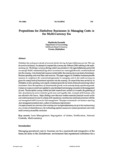Please use this identifier to cite or link to this item:
https://cris.library.msu.ac.zw//handle/11408/655Full metadata record
| DC Field | Value | Language |
|---|---|---|
| dc.contributor.author | Mazhindu, Kenneth | - |
| dc.date.accessioned | 2015-09-11T14:32:25Z | - |
| dc.date.available | 2015-09-11T14:32:25Z | - |
| dc.date.issued | 2014 | - |
| dc.identifier.issn | 1815-9036 | - |
| dc.identifier.uri | http://hdl.handle.net/11408/655 | - |
| dc.description.abstract | Zimbabwe has undergone a decade of economic decline during the hyperinflationary period. This was its worst in its history. An attempt to jumpstart the economy saw February 2009 ushering in the multicurrency era. The foreign currency shortage which was prevalent in the hyperinflationary period did not ease off. Neither substantial foreign direct investment nor meaningful domestic investment flowed into the economy. A low level of cash resources existed within the economy due to low levels of investment. Business operating costs erode these cash resources. This paper suggests to Zimbabwe businesses possible measures to complement the conventional approaches to managing costs in this multi currency era given the scanty levels of investment injections into the economy. No research has been carried out in Zimbabwe on how operating costs may be contained given the low levels of domestic and foreign direct investment. Given the importance of investment for growth, as the economy slowly experiences growth, it draws on measures which were applied in some developed and emerging economies in the management of costs. The descriptive survey method and desk research were carried out to enable the gathering of data .Questionnaires and an interview guide were used to gather data. A sample of 30 business units was selected in the Gweru.. Major findings were that most entities maintain financial records not for cost control purposes but just to comply with regulations; most business units lack personnel with the cost management skills to practice lean management. The paper recommends cost variance reporting ,lean management practices and a culture of continuous improvement. The paper presents an overview of the economy over the hyperinflationary era up to the multicurrency era, a review of related literature, the methodology applied, measures to contain operational costs in the multi currency era and the conclusion. | en_US |
| dc.language.iso | en | en_US |
| dc.publisher | Midlands State University | en_US |
| dc.relation.ispartofseries | The Dyke;Vol.8, No.1, p. 142-155 | - |
| dc.subject | Lean management, segregation of duties, verification, internal controls, multicurrency | en_US |
| dc.title | Propositions for Zimbabwe businesses in managing costs in the multi-currency era | en_US |
| dc.type | Article | en_US |
| item.grantfulltext | open | - |
| item.openairecristype | http://purl.org/coar/resource_type/c_18cf | - |
| item.openairetype | Article | - |
| item.fulltext | With Fulltext | - |
| item.cerifentitytype | Publications | - |
| item.languageiso639-1 | en | - |
| Appears in Collections: | Research Papers | |
Files in This Item:
| File | Description | Size | Format | |
|---|---|---|---|---|
| mazhindu.pdf | 7.11 MB | Adobe PDF |  View/Open |
Page view(s)
156
checked on Oct 16, 2025
Download(s)
86
checked on Oct 16, 2025
Google ScholarTM
Check
Items in MSUIR are protected by copyright, with all rights reserved, unless otherwise indicated.



